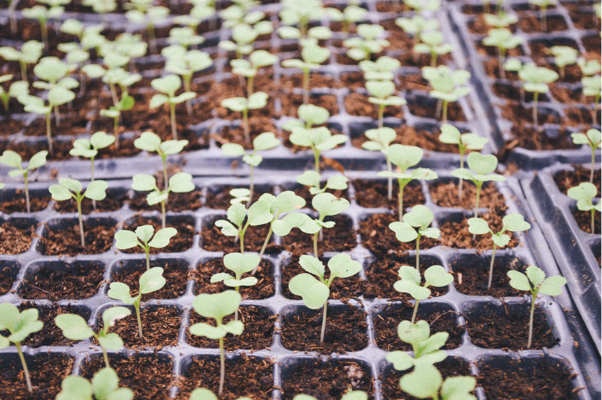By Liz Slocum Jensen April 26, 2018
The future of agriculture naturally overlaps with the future of food since it lies upstream with our food supply. As the population grows, the world will need to increase the food supply. The Food and Agriculture Organization of the United Nations cites that we’ll need to produce as much as 70% more food by 2050. These companies are taking a variety of approaches to solving sustainability, including
- how we grow food,
- producing alternative food,
- re-evaluating how we manage the supply chain.
Hyperlocal Indoor Farming: Salads for the Affluent
Alot of indoor farming hardware innovation is happening in cannabis industry. You can read my thoughts about it here. After marijuana, greens (inclusive of lettuce, kale, spinach) are the second largest revenue-generating indoor crop at $64 per square foot. Thank goodness people are still interested in growing food!
With Controlled Environment Agriculture (CEA), tech companies are creating equipment that are water- and energy-efficient. By being hyperlocal, they are shortening the supply chain while capitalizing on consumers’ growing tastes for “farm-to-fork” foods. Alesca Life offers ready-to-use, connected indoor farms in shipping containers. However, they are currently focused on smaller onsite hydroponic “greenhouse cabinets.” The business model brings the farm to the customer; meaning, the customer pays for the installation and maintenance and then buys the produce as a subscription. You’ll see these in hotel restaurants and other high-end hospitality groups in China and the UAE.
Bowery Farming, Gotham Greens, and Brightfarms are producing their salads as consumer packaged goods (CPG). These companies grow near major cities like New York City and Chicago so that they can deliver within 10 miles. In some cases, the farm is atop a roof of a Whole Foods in Brooklyn.
So this is great for an affluent city dwellers who can pay the premium for salad grown within 10 miles. But how else are we going to feed the population? Keep in mind, our goals is to feed 2.3 billion more people while combating poverty and hunger and using scarce natural resources more efficiently. These companies adds value along the existing supply chain and redefines nutrition.
Bugs as food
I’ve eaten bugs in various forms, including seasoned larvae snacks, in a soup, and in a blueberry muffin. The muffin tasked like any other muffin and the rest and I would describe them as earthy and inoffensive. Admittedly, I can see this as an acquired taste with a niche market. Consider this: bugs are an efficient form of protein, whether for human or pet consumption. It takes so much more grain, land, and water to raise an animal to produce a pound of meat than it does to grow just grain for food. Then the animals burp and farts a remarkable amount of greenhouse gases. Looking forward and considering the environment, we will need to reimagine how we grow our food and how we get our protein.
Entocube and Tiny Farms have created insect farming systems. Entocube has a simple, stackable system of plastic containers with egg cartons. This low-energy design is a viable solution anywhere, but especially in places in energy is too expensive or inaccessible. The more IoT-driven approach is with Tiny Farms. They have created smart farms with sensors, data collection, and automation. These farms have marketable potential as we seek efficiencies in food production. Admittedly, this a harder sell since they working against legacy systems that have spanned generations and mainstream consumer tastes that may not be ready for bugs. This is a work in progress. The makers of Chirps Chips are trying to gain adoption of their bug chips in mainstream America. Remember when kale was just a way for restaurants to decorate their salad bars? For a less appetizing example, check out this Thrillist list of every U.S. state’s grossest foods. The point is that food tastes change over the years so this could catch on with consumers or reach a tipping point in which it is viable for pet food.
Recapturing produce in the supply chain
Farmers are losing up to 40% of their harvest for reasons varying from harvest timing, poor planning, labor shortages, or products not meeting aesthetic standards. Companies such as Ninjacart and La Ruche qui Dit Oui! are optimizing the supply chain by offering online location-based platforms to connect farmers with customers.
Meanwhile, Full Harvest (B2B) and Imperfect Produce (B2C) are taking different approaches to the value chain by broadening cosmetic standards for food that is considered not sellable while finding secondary markets for this food. These companies reveal how picky consumers are about produce and that there’s a lot of food and money being left on the table.
All of these companies have two challenges with the end consumer.
(1) They have to change consumers’ norms about palatability and aesthetics .
(2) They need consumers to ask themselves at each meal whether they are willing to pay a premium price for their values.
In some of these cases, the most technical project isn’t going to have the biggest impact. It could be the low-tech, but newly designed, process that helps us feed the world.

